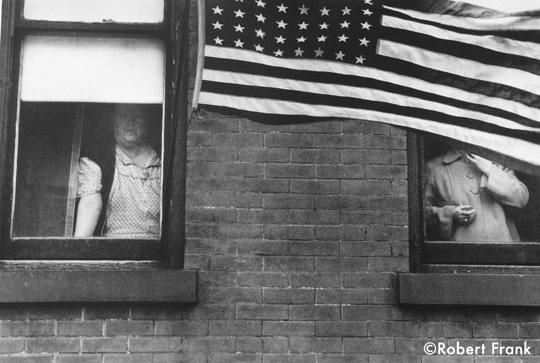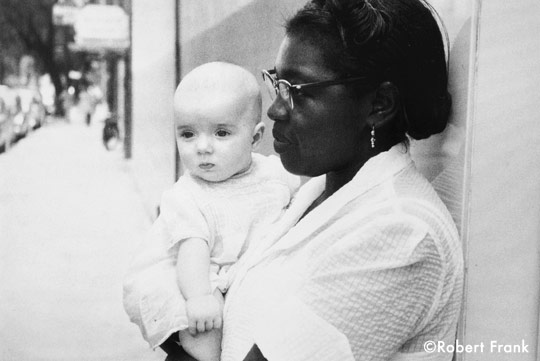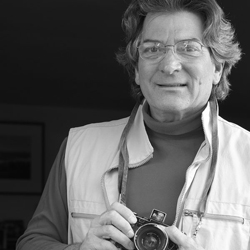A powerful photograph can change our lives and help us better realize who we are and the world we live in. By defining and immortalizing a moment so indelibly and with great skill the image itself takes on transcendental qualities. When this is done within a whole group of photographs the experience can be awesome, historically relevant and can alter the course of an art form. Such is the case with Robert Frank's seminal work "The Americans" which is currently on view at the Museum of Contemporary Art (MOCA) on Grand Ave in downtown Los Angeles. I can with full confidence suggest you see this amazing set of photographs in person, not only for their historical significance, but to experience the photographs first hand, in the way Frank choose to have them printed and viewed.
Frank who was born in Zurich, Switzerland in 1924 immigrated to the United States in 1947. In 1955, with the aid of his major artistic influence, the photographer Walker Evans, Frank secured a grant from the Guggenheim Foundation to travel across the United States and photograph its complexity at all levels. What's especially important to keep in mind is that his approach to creating these pictures was intense, raw, and committed to showing a side of American life rarely seen before. He courted both risk and failure. He was arrested and seriously harassed in the South. Rather than glorifying the American dream he was interested in documenting and expressing the tensions between the optimism of the 1950's and the realities of class and racial differences.
His pictures shocked the public at first. He looked under the facade of American life to expose a people infected with racism, ill served by their politicians, and exploited by a rapidly expanding culture of consumerism.
American publishers originally rejected the work because it didn't fit into the idea of America as expressed by the popular TV show of the time "Father Knows Best" or the clean wholesome image presented by the painter Norman Rockwell. It didn't support the cold war mentality of America as the land of the free and equal opportunity for all. The photographs showed an America different from the sanitized, non- threatening photo essays offered in popular photo magazines. Robert Frank made photographs of factory workers in Detroit, transvestites in New York, and black passengers on a segregated trolley in New Orleans, cars, jukeboxes, dangerous bars, and desolate highways. These images made "The Americans" so extraordinary, more of a visual poem than a literal document.
The phenomenal art director and editor Robert Delpire in France first published the book, "Les Americains" in 1958. It was eventually published in America by Grove Press in 1959. When  looking back on it now, it seems almost unbelievable that the book then received substantial criticism. Frank's pictures were described as a sad poem by a very sick person. Even the Museum of Modern Art in NYC wouldn't carry the book in their store, a sore point to this day for Frank. But just like the way Rock and Roll challenged the status quo "The Americans" eventually won everyone over with high praise; younger photographers especially embraced it.
It is my opinion that Robert Frank brought the "BLUES" to black and white 35mm photography. His pictures are intuitive and loose but also finally honed, intense and deeply moving. For this contribution photographers owe Frank a huge debt. There were other B&W photographer's who preceded him and helped him realize his own talent such as Kertez, Bresson, Brassi, Evans, Capa, and Eugene Smith.
His gritty, in your face images, as well as his more subtlety seen and elegantly composed photographs attest to the great strength and artistry found in the medium of photography. Some of the pictures in the exhibit are extraordinary. They surpass the subtext of the social commentary and maneuver into the rare world of distinguished works of art. The vertical shot of U.S. highway 285, New Mexico is such an image. The ominous sense of light hitting the pavement along with the striking composition is visually absorbing. It implies a journey to nowhere or then again maybe a life-changing journey to somewhere special, unknown and mysterious, both haunting and inviting.
The photograph of an angelic white baby being tenderly held by a black as night Nanny is an exceptional print. The range of tonality in the photograph is spectacular. The image itself suggests the baby is completely oblivious to racism, not old enough or jaded to the South's desperate embrace of prejudice.
Probably the best know photograph of the whole group, Parade, Hoboken, New Jersey is of two figures standing behind their apartment windows separate from one another. They appear almost like ghosts or apparitions and are darkly secretive, yet we know they are real. They are framed and connected by an American flag that is placed on the front of the brick building in which they live. The flag appears distressed, off kilter like an amputated limb. Visually this photograph is stunning, perhaps one of the greatest photographs ever taken.
"The Americans" will be on view through October 19, 2009 at MOCA, 250 South Grand Avenue, Los Angeles.
looking back on it now, it seems almost unbelievable that the book then received substantial criticism. Frank's pictures were described as a sad poem by a very sick person. Even the Museum of Modern Art in NYC wouldn't carry the book in their store, a sore point to this day for Frank. But just like the way Rock and Roll challenged the status quo "The Americans" eventually won everyone over with high praise; younger photographers especially embraced it.
It is my opinion that Robert Frank brought the "BLUES" to black and white 35mm photography. His pictures are intuitive and loose but also finally honed, intense and deeply moving. For this contribution photographers owe Frank a huge debt. There were other B&W photographer's who preceded him and helped him realize his own talent such as Kertez, Bresson, Brassi, Evans, Capa, and Eugene Smith.
His gritty, in your face images, as well as his more subtlety seen and elegantly composed photographs attest to the great strength and artistry found in the medium of photography. Some of the pictures in the exhibit are extraordinary. They surpass the subtext of the social commentary and maneuver into the rare world of distinguished works of art. The vertical shot of U.S. highway 285, New Mexico is such an image. The ominous sense of light hitting the pavement along with the striking composition is visually absorbing. It implies a journey to nowhere or then again maybe a life-changing journey to somewhere special, unknown and mysterious, both haunting and inviting.
The photograph of an angelic white baby being tenderly held by a black as night Nanny is an exceptional print. The range of tonality in the photograph is spectacular. The image itself suggests the baby is completely oblivious to racism, not old enough or jaded to the South's desperate embrace of prejudice.
Probably the best know photograph of the whole group, Parade, Hoboken, New Jersey is of two figures standing behind their apartment windows separate from one another. They appear almost like ghosts or apparitions and are darkly secretive, yet we know they are real. They are framed and connected by an American flag that is placed on the front of the brick building in which they live. The flag appears distressed, off kilter like an amputated limb. Visually this photograph is stunning, perhaps one of the greatest photographs ever taken.
"The Americans" will be on view through October 19, 2009 at MOCA, 250 South Grand Avenue, Los Angeles.
 looking back on it now, it seems almost unbelievable that the book then received substantial criticism. Frank's pictures were described as a sad poem by a very sick person. Even the Museum of Modern Art in NYC wouldn't carry the book in their store, a sore point to this day for Frank. But just like the way Rock and Roll challenged the status quo "The Americans" eventually won everyone over with high praise; younger photographers especially embraced it.
It is my opinion that Robert Frank brought the "BLUES" to black and white 35mm photography. His pictures are intuitive and loose but also finally honed, intense and deeply moving. For this contribution photographers owe Frank a huge debt. There were other B&W photographer's who preceded him and helped him realize his own talent such as Kertez, Bresson, Brassi, Evans, Capa, and Eugene Smith.
His gritty, in your face images, as well as his more subtlety seen and elegantly composed photographs attest to the great strength and artistry found in the medium of photography. Some of the pictures in the exhibit are extraordinary. They surpass the subtext of the social commentary and maneuver into the rare world of distinguished works of art. The vertical shot of U.S. highway 285, New Mexico is such an image. The ominous sense of light hitting the pavement along with the striking composition is visually absorbing. It implies a journey to nowhere or then again maybe a life-changing journey to somewhere special, unknown and mysterious, both haunting and inviting.
The photograph of an angelic white baby being tenderly held by a black as night Nanny is an exceptional print. The range of tonality in the photograph is spectacular. The image itself suggests the baby is completely oblivious to racism, not old enough or jaded to the South's desperate embrace of prejudice.
Probably the best know photograph of the whole group, Parade, Hoboken, New Jersey is of two figures standing behind their apartment windows separate from one another. They appear almost like ghosts or apparitions and are darkly secretive, yet we know they are real. They are framed and connected by an American flag that is placed on the front of the brick building in which they live. The flag appears distressed, off kilter like an amputated limb. Visually this photograph is stunning, perhaps one of the greatest photographs ever taken.
"The Americans" will be on view through October 19, 2009 at MOCA, 250 South Grand Avenue, Los Angeles.
looking back on it now, it seems almost unbelievable that the book then received substantial criticism. Frank's pictures were described as a sad poem by a very sick person. Even the Museum of Modern Art in NYC wouldn't carry the book in their store, a sore point to this day for Frank. But just like the way Rock and Roll challenged the status quo "The Americans" eventually won everyone over with high praise; younger photographers especially embraced it.
It is my opinion that Robert Frank brought the "BLUES" to black and white 35mm photography. His pictures are intuitive and loose but also finally honed, intense and deeply moving. For this contribution photographers owe Frank a huge debt. There were other B&W photographer's who preceded him and helped him realize his own talent such as Kertez, Bresson, Brassi, Evans, Capa, and Eugene Smith.
His gritty, in your face images, as well as his more subtlety seen and elegantly composed photographs attest to the great strength and artistry found in the medium of photography. Some of the pictures in the exhibit are extraordinary. They surpass the subtext of the social commentary and maneuver into the rare world of distinguished works of art. The vertical shot of U.S. highway 285, New Mexico is such an image. The ominous sense of light hitting the pavement along with the striking composition is visually absorbing. It implies a journey to nowhere or then again maybe a life-changing journey to somewhere special, unknown and mysterious, both haunting and inviting.
The photograph of an angelic white baby being tenderly held by a black as night Nanny is an exceptional print. The range of tonality in the photograph is spectacular. The image itself suggests the baby is completely oblivious to racism, not old enough or jaded to the South's desperate embrace of prejudice.
Probably the best know photograph of the whole group, Parade, Hoboken, New Jersey is of two figures standing behind their apartment windows separate from one another. They appear almost like ghosts or apparitions and are darkly secretive, yet we know they are real. They are framed and connected by an American flag that is placed on the front of the brick building in which they live. The flag appears distressed, off kilter like an amputated limb. Visually this photograph is stunning, perhaps one of the greatest photographs ever taken.
"The Americans" will be on view through October 19, 2009 at MOCA, 250 South Grand Avenue, Los Angeles.









